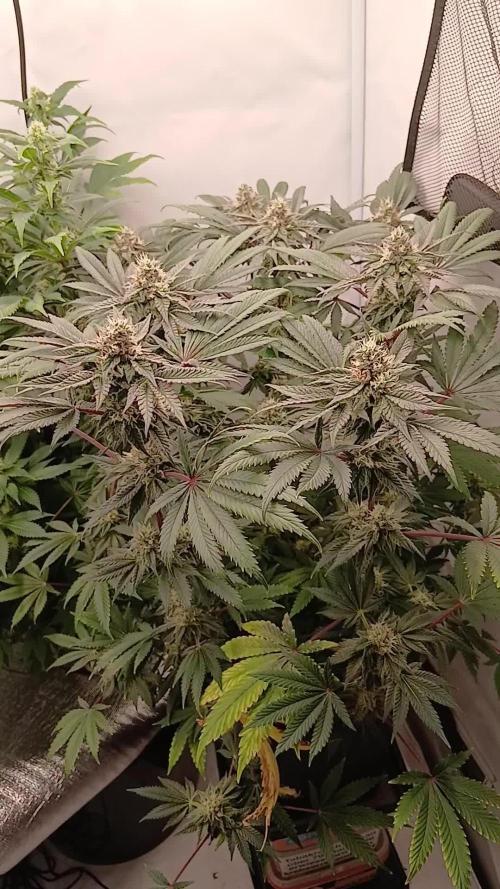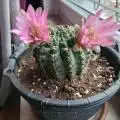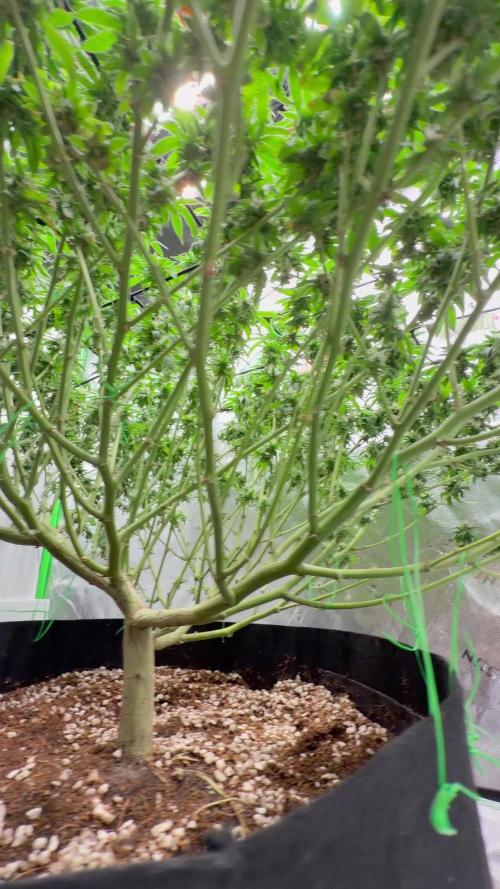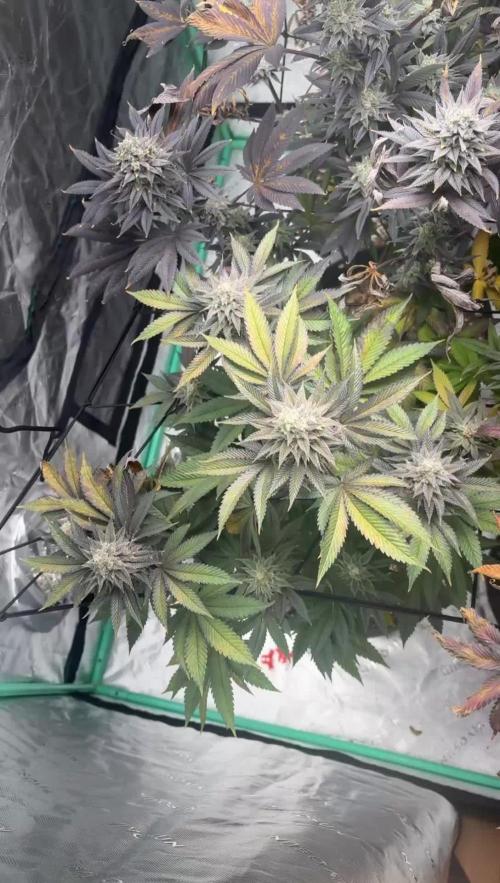The Grow Awards 2026 🏆 

































Likes
Comments
Share


@nonick123
Follow
Día 87 (26/08) Aplicación foliar de Bacillus thuringiensis a 1 g / litro para evitar a las temidas orugas de los cogollos!
Hace un día nublado (29 ºC de maxima) y NO es necesario regar
Elimino la malla de sombreado de la cara sur, ya que las temperaturas son más suaves después de la canicula
Día 88 (27/08) Riego con 500 ml H2O pH 6,5
Empiezan a bajar las temperaturas a 29 ºC de máxima, y se nota en la demanda de agua por parte de las plantas!
OnionOG Se empiezan formar los erizos y se pueden apreciar los primeros tricomas sobre las futuras hojas de azucar 😍💥
Día 89 (28/08) Riego con 500 ml H2O pH 6,5
Cada planta empieza a ir un poco a su marcha en la demanda de riego dependiendo de su tamaño y estado de floración
Día 90 (29/08) Riego con 250 / 500 ml H2O pH 6,5
He detectado un gusano de los cogollos muerto sobre una hoja! 💥 Parece que los Bacillus thuringiensis funcionan estupendamente! 😁
Día 91 (30/08) Riego con 250 / 500 ml H2O pH 6,5
Día 92 (31/08) Riego con 1 litro H2O pH 6,5 + 25 ml de Humus de Lombriz Liquido
Día 93 (01/09) Aplicación foliar Bacillus Thuringiensis
No es necesario regar tras el litro de ayer y dia nublado con pequeños chubascos!
💦Nutrients by Lurpe Solutions - www.lurpenaturalsolutions.com
🌱Substrate PRO-MIX HP BACILLUS + MYCORRHIZAE - www.pthorticulture.com/en/products/pro-mix-hp-biostimulant-plus-mycorrhizae
Likes
2
Share


@Ryno1990
Follow
Week 5 of veg for this girl she's been picking up some size still the smallest girl but not by much she's deff been growing nice an healthy under this fold 6 from medic grow she's I nice little bush with some big fan leafs
Ending week 5 this girl is doing good she's not the smallest one but she's not to far ahead she has been doing great since her transplant into her final pot so hopefully she'll start picking up some size
Likes
6
Share


@BettyFlores
Follow
04.12.2025 Well, not much time left to be harvested. Her trichomes are already milky and the sugarleaves are very frosty. Her buds are getting bigger and the colors are really beautiful, with her orange pistiles. I'll give her some more days and check again on her. And I'm suspicious that I unintended pollinized some parts of her, while intentionally pollinating the Gelato x Black Lebanon with the Agent Orange-Male. Looking forward 🌸💜
Likes
7
Share


@Canna96
Follow
Hey now, I hope everyone is having a great weekend. The ladies had another great week, I got the Durban Nights, Red Hot Cookies, and Sundae Driverr's second toppings completed on day 26, and I got the second toppings done on the Green Crack and Bubble Runtz on day 27. Right now I have 4 mains on each plant, and I will top each one this week, probably in the next 3-4 days which will leave with me 8 mains. So the mainlines will be completed during week 5, and I plan to flip to flower around week 7.
I am still seeing a couple holes on the leaves of the Sundae Driver, but I have treated her twice with neem oil and I don't see any new holes since the last application and I can't see any bugs even with magnification. I am still not sure if it was a bug issue or just a genetic thing. Either way I am not too concerned at this point because they all seem to be very healthy.
I am still feeding GH nutrients, silica, cal mag, and maxi grow. I will transition to flower nutrients approximately one week after flipping to flower. I have found that it is important to continue feeding plenty of Nitrogen through the stretch. The only way I would transition sooner is if I was running out of vertical space.
Still very pleased with the Spectrum X from Medic Grow. I am running her at 69% and the plants seem very happy and healthy. The heat and humidity are finally letting up in my region so it is nice to be able to open some windows and drop the temp outside the grow tent.
I hope everyone has a great weekend, Thanks for stopping by, Stay Safe and Blaze On!!! 💪
Website: https://medicgrow.com/
https://growdiaries.com/grower/medicgrowled
Likes
40
Share


@valiotoro
Follow
easy trim✂️
The buds are Absolutely perfect,exactly what i was looking for🤩
Green pheno : cookie,diesel & gelato🍪⛽️🍦
Purple pheno : flower,sweet & honey🌸🍯
After 7 days on the dry rack she was ready for the jar to start the curing process.😋
Likes
8
Share


@HowtoBubatz
Follow
The plants are doing amazing! Both are producing more and more trichomes, and the buds are noticeably thickening up.🌱
#1 (the tall one) continues to impress—it’s now giving off a strong tropical mango scent! The aroma is so sweet and fruity, it’s crazy.
Meanwhile, #2, despite being so small, has developed a surprisingly large main bud!
The smell is completely different, though—leaning more towards a hazy, complex scent that’s hard to describe.🤔
Super happy with the progress so far—let’s see what the next weeks bring!😊
Likes
13
Share


@FlavoursUk
Follow
New week, new growth.. Will hopefully start the LST and Topping in a few days. They are really starting to grow. Fan leaves looking healthy and big.
Girls coming with vigorous growth now, everything dialled in and happy. Just adjusting the EC/pH as needed when the girls show me the relevant signs/deficiencies if any.
D31/D35- Decided they were in a good enough place to start topping the girls, all 6 topped and just some defoliation of the bigger fan leaves that are shading the growth shoots some HST was also done.
We were also due a water change, so I cleaned the whole system just to keep things extra cleanly, very important in a RDWC system. I also switched over to a sterile system instead of using beneficial bacteria so I will experiment and see how this goes.
Time to let the girls ecover before the next training session.
Cruise control for now.
Processing
Likes
1
Share


@GaliforniaWeeds
Follow
12/8/20 día 21 de vegetativo
Hoy comenzamos el seguimiento de estas nenas de 21 días. Hasta ahora han estado en contenedor de 1l y hoy he transplantado al de 7l que será el definitivo para que no cojan demasiada altura ya que siempre hago vegetativos largos.las pequeñas están muy sanas y fuertes a pesar de que sólo han sido regadas con agua base ( 0,4 ec) y ryzofuel, el enrraizante de Cyco. En el próximo riego comenzaremos a fertilizar suavemente y esperemos que las temperaturas comiencen a bajar ya que por el momento están demasiado altas. Veremos como se adaptan a sus nuevos contenedores. No te pierdas las actualizaciones.
14/8/20 día 23 de vegetativo
Nuestras nenas se adaptan bien a su nuevo contenedor, no se observan muchos cambios pero todo sigue avanzando bien. Hacemos un riego preventivo con propolix ya que la botrytis es una amenaza constante en mi zona. El riego será de 0,5l por planta. Las temperaturas y humedad continúan sin cambios por el momento aunque en los próximos días espero que bajen un poco. En cuanto el sustrato esté seco comenzaremos la nutrición con la gama completa de Cyco platinum series que siempre me da grandes resultados (podéis verlos en Instagram en @galiforniaweeds). Seguiré actualizando el diario día si día no, no te lo pierdas, dela tu like y sígueme. Buenos humos y prósperas cosechas!!
16/8/20 día 25 de vegetativo.
Las nenas avanzan sin sorpresas. He preparado un riego con los productos Cyco indicados más arriba. Es un riego con una nutrición suave de 0,65 de ec y un ph de 6,1. Las temperaturas rondan los 25 grados durante el día y 22 durante la noche, la humedad se mantiene entre un 60 y un 65%. La mayoría de las nenas han ganado un par de cms estos días, actualizare su altura cada semana En la tabla superior para poder comparar los avances. Dejad vuestros comentarios y likes compis. Buenos humos
18/8/20 día 27 de vegetativo.
Buenos días compañeros growers.todo avanza con normalidad en nuestro cultivo, las plantas de fortalecen y crecen día a día hoy hemos echo otro riego con los productos arriba mencionados, con una ec de 0,75 y un ph de 6,2. Las temperaturas han bajado un poco y están donde a mi me gustan, en unos 22,5 durante el día y a unos 20 durante la noche. Por otro lado la humedad está en un 63% con lo que las condiciones son las idóneas para un crecimiento estable. Arriba os he dejado una foto y un vídeo para que comprobéis El Progreso. Buenos humos y prósperas cosechas hermanos
Likes
14
Share


@exclusiveX420
Follow
Another really good week. We officially have flower sites as of Monday 3/27 first day of flower!!!!
She is such a monster now! I am really excited to move into flower. I have the plant opened up some more and hoping I can penetrate beneath the surface without side lighting this round. We will see !
The other sour clone I had running, same skunktek is doing well and just got setup with blumat Tropf drip Irrigation!
Stay tuned
Likes
54
Share


@TechDCo
Follow
08/05/2024
Lights On!
Dark Purples & Pinks!
I wasn't expecting Forgotten Haze to have these hues in it! Amnesia White & Vanilla Haze cross!
09/05/2024
Lights On!
During her Lights Off period, she consumed 8 liters of water. I noticed a significant increase in the size of the buds since yesterday, and they appear much frostier.
Honestly these buds look bigger to the eye
I smoked some early under buds last night!
Likes
2
Share


@Bluemels
Follow
Tag 52: Ich habe die Cookies Gelato erneut entlaubt um mehr Struktur zu schaffen. Die Pflanze bildet dermaßen viele Verzweigungen aus die auch noch so winzig sind, das ich denke mich für die falsche Pflanze entschieden zu haben. Jetzt ist es zu spät und ich muss mit dem Arbeiten was ich hier hab 😆
Tag 54: Die Pflanze wächst im zeitlupentempo weiter 😞
Likes
37
Share


@Budz_Bunny
Follow
Grow Journal Week 5: Bloom Phase Progress 🌼
Hello dear growers and growerettes,
I’m thrilled to share the fifth week of the bloom phase in our grow journal! Here are all the details for Week 5:
Weekly Progress
It's been a typical week of development for the plants. Not much has happened aside from the usual growth. However, I had to reset my watering system due to an error, which involved removing the mulch layer. Since then, I've been closely monitoring to ensure the watering remains consistent.
Watering and Control Systems
After resetting the watering system due to an error, everything seems to be back on track. I'm observing the system closely to ensure its consistent performance.
Challenges
This week, the defoliation process has been particularly challenging, even though it usually goes smoothly. There are just too many fan leaves with trichomes this time.
Goals and Expectations
I am curious to see how the plants will continue to develop over the next two weeks, as this period will give me a good indication of what to expect at harvest.
Thank you for following along, and stay tuned for more updates! 🌿✨
Likes
6
Share


@Edwinbarragan
Follow
Cada día crecen más esta semana las pasamos a floración y mostraron un buen desarrollo sin estrés ni deficiencias alguna, detectamos en la candy crush que se volvió hermafrodita,posteriormente la retiramos del cuarto de cultivo........
Likes
8
Share


@Fyno_TH
Follow
🌸 Flowering Week 5 — Solo Queen Still Standing 👑
Tough week but the mission continues 🌿💪 One plant didn’t make it earlier, so now all focus goes to the remaining Queen. She’s holding up strong — stacking dense buds and shining beautifully under the Spider Farmer G3000 💡
Switched fully to Athena Bloom (2 ml/L) after running out of Florex, and it’s working great so far — tighter buds, stronger pistil growth, and that classic King’s Juice aroma starting to roll in 🍊✨
Feed (per L):
• Corex – 1 ml
• Mira – 0.5 ml (pH adjust)
• Aurora – 1 ml
• Oxyroot – 1.5 ml
• Bud Candy – 2 ml
• Terpinator – 5 ml/gal (~1.3 ml/L)
• Athena Bloom – 2 ml
💧 ~15 L each with 10–20 % runoff
⚗️ PPM: 1760 | EC: 3.5 | pH: 6.0
🌡️ Temp: 26–28 °C (day) / 23 °C (night)
💧 RH: 45–50 %
Likes
17
Share


@sunshinegroww
Follow
had some plant bends put in to open her up a little ,tis one growing very fast lol
Processing
Likes
11
Share


@MELs_Garden
Follow
Semana 6 (7-13 de mayo)(días 36 - 42)
Contentos con como va la cosa, retiramos alguna hoja tocada y poco mas. 😊😊
11/5/2020
El ultimo riego fue bastante heavy y podemos ver como las puntas muestran signos de sobrefertilicacion ,por tanto este riego va a ser más suave. Teniendo en cuenta que sufrimos el problema de quedarnos sin fertilizantes y que nuestro proovedor debido a la situación actual del covid tiene el asunto complicado tocaremos con lo que tenemos.
Hoy toca riego en el que usamos 40l ñara 22 plantas. Los riegos se realizan en garrafas de 10l por lo que los valores varían en función de las plantas.
(Valores • l)
• 1gr de biogreen flower boost + 1ml calcio max + 1ml Mg
PH: 5 94
EC: 1.21
T h2O: 18,5°C
• 1gr de biogreen flower boost + 1ml calcio max + 1ml Mg + 0.2ml Final solution
PH: 5 84
EC: 1.00
T h2O: 18°C
• 1gr de biogreen flower boost + 1ml calcio max + 1ml Mg + 0.2 Final Solution
PH: 5 81
EC: 1.18
T h2O: 17,3°C
• 1gr de biogreen flower boost + 1ml calcio max + 1ml Mg
PH: 6
EC: 1.44
T h2O: 17,2°C
Para algunas variedades como la Bubba y la Barney Kid será su último riego con fertilizantes, a partir de ahora haremos riegos com flush hasta el momento de corte para que no queden restos en nuestras flores en el momento final. Al resto sin embargo les quedará alrededor de 3/4 semanas por lo menos. Esto sigue avanzando y se siguen formando nuevas flores pero esperemos que esto no tarde mucho en engordar, porque a pesar de que se que son de floración larga me da la sensación de que podrían estar mejor, no se si debido al cambio de nutrientes y de que no estoy cubriendo todas las necesidades que tienen. A pesar de todos tenemos unas Orange sherbert que pintan increíbles, una berry mint potente, dos chocolate mint OG que dan ganas de comérsela...
Por comentar que ayer dejo de funcionarios uno de los focos 😔 tras echarle un ojo y hacer unas pruebas comprobamos que el fallo era del cable y ya esta solucionando 😁😁
Estoy disfrutando mucho con este cultivo y aprendiendo de los fallos, sólo viendo como van y con las cosas que he aprendido no veo el momento de comenzar con el siguiente cultivo, pero paso a paso 🤗
Por cierto estos últimos días la temperatura a bajado bastante por el mal tiempo lo que nos ha venido genial para estabilizar la temperatura en unos 25/26°C en ON y 22/23°C en OFF. Estos días atrás rondaba más los 28/29°C llegando en algún momento a 30. Un poco de frescura para el huerto.
Y por último, pero no menos importante. Mi pareja, a la que tanto quiero, me va a dejar su móvil para sacar fotos. La diferencia es abismal por lo que intentaremos mejorar la cantidad de nuestro contenido para el bien de todos 😁😁
Likes
27
Share


@Smokepurple137
Follow
Stretching really well in 2nd week don't think I will veg them too long, maybe another 2-3weeks, been able to top 2 of them so far. I will be topping all of them just the once. Growing slightly quicker than the last barney's seeds I used. All looking very healthy.





















